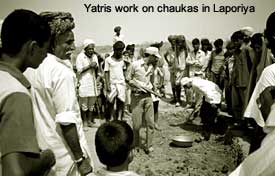| |
A NEW BEGINNING |
|
| Forging
ties
|
||
| WATER LITERACY | ||
| Informing
people Water play The facilitator Water Gala |
||
| IN FOCUS | ||
| Faulty
perceptions Thirst rises, patience evaporates |
||
| URBAN WETLANDS | ||
| Eviction
ordered Join the BIG fight Citizens pick up cudgels Solar lakes |
||
| WATER MANAGEMENT | ||
| South
India: Searching for an identity Thailand: Then came progress.... |
||
INITIATIVE |
||
| An eye
opener Naudihi’s revival Tankas of Badi Ghodan Dialogue |
||
CSE'S LATEST DESIGNS |
||
| Sri
Aurobindo Ashram’s system |
||
TECHNOLOGY |
||
| Rice
husk ash filter Clay pot irrigation |
||
| JAL YODHAS | ||
| Sachidanand
Bharti Madhu Bhatnagar |
||
TRADITION |
||
| Naullahs
of Kumaon |
||
WATER IN NEWS |
||
| Kerala,
building up its jalanidhi Schemes or scams? |
||
GREEN WATER HARVESTER'S NEWS |
||
| Saving
lives Rain associations Review |
||
CLASSROOM |
||
| Drop by
drop Water scramble |
||
FUNDING AGENCY |
||
| Oxfam
and water |
||
| 100
promises, deadline 2006 The landmarks Changing currents |
||

| Vol. 5 | No. 2 |
April-May 2003 |
|||
"By slightly modifying the size of the pyathon (concrete catchment area), kundis can be easily replicated in some parts of Orissa, where options for groundwater recharge are limited". Leela Nanda, MASS, Orissa "The chauka system is a remarkable way of not only developing pastureland but ensuring high groundwater retention as well. It is a system, which can be effectively replicated in Kenya, as the ecological and topographic conditions are similar." Alex Odour, Information Officer,RELMA, Kenya  Similar thoughts were expressed by other participants of CSE’s
tenth paani yatra (water pilgrimage) as well. About 28 participants with diverse
backgrounds from (different parts of) India, Kenya and Germany explored Rajasthan, during
this yatra. Travelling between May 12 - 19, 2003, they saw the magic of kundis (concrete
structures to collect water) in village Ramsara and Ratanpur, Churu; chaukas (dykes) in
Laporiya village, Jaipur; and, johads (earthen pond) in Bhaonta Kolyala village, Alwar. Similar thoughts were expressed by other participants of CSE’s
tenth paani yatra (water pilgrimage) as well. About 28 participants with diverse
backgrounds from (different parts of) India, Kenya and Germany explored Rajasthan, during
this yatra. Travelling between May 12 - 19, 2003, they saw the magic of kundis (concrete
structures to collect water) in village Ramsara and Ratanpur, Churu; chaukas (dykes) in
Laporiya village, Jaipur; and, johads (earthen pond) in Bhaonta Kolyala village, Alwar.
The first stop was village Ratanpura. Here, with the help of Bhoruka Charitable Trust, a local NGO, the community is maintaining kundis, as a realiable drinking water source. The groundwater in this village is saline and the municipal supply is irregular. On the way to Churu, next stop was Raju ki Dhani village, where they saw kui, another traditional structure to harness moisture from sands. Yatris were surprised to find that the water in the kui was sweet, whereas in a nearby well it was saline, as the former source was not groundwater. In Ramsara village, they meet villagers, who have built six new kundis, last year, as the groundwater was flouride affected. In this village, kundis were also being used for irrigation purposes. Here, they met Ridkaran, a mason, who has been making kundis for the past 25 years. In Laporiya, chaukas captivated the group. It is a unique method of rainwater harvesting, involving dyked rectangular trenches dug all over the pastureland in a series. The depth of these pits vary with the local topography. The rainwater goes zig zag all around pasture before flowing into a seasonal river. The villagers are regularly maintaining the catchment area and, a canal supplies water to the three tanks built in a series — ‘ann sagar’, ‘phool sagar’ and ‘dev sagar’. After four years of drought, although the surface water has dried up. There is enough water for both drinking and irrigation. The dairy sector is flourishing. The average annual income per household from this sector alone varies between Rs 2,000 to Rs 4,000. There are 103 wells in the village. And, people are using these for one hour to irrigate. Their lush green agricultural land highlights the impact of the innovative community-based water works done in Laporiya. A trend that was not observed by the yatris during their visit to the other neighbouring villages. The visit was an eye opener. Bhanu Jain, a yatri from Water and Sanitation Management organisation, Gandhinagar, said, "An effective social mobilisation rocess has transformed these into model villages that are easy to replicate. For details:Rampal Bisht, BCT, Rajgarh, Bhorugram, Churu 331023 Laxman Singh, GVNML, Laporiya, Post Gagardu, Dudu, Jaipur 303008
|
|||||